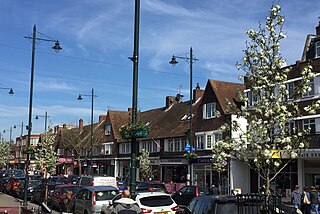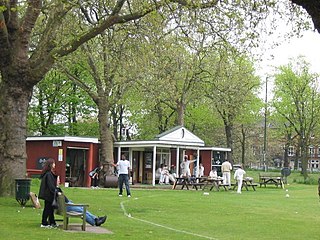This article needs additional citations for verification .(January 2017) |
Whitton Park was a country house in the village of Whitton in Twickenham, Middlesex. It was demolished in the 1840s and gradually replaced with housing. [1]
This article needs additional citations for verification .(January 2017) |
Whitton Park was a country house in the village of Whitton in Twickenham, Middlesex. It was demolished in the 1840s and gradually replaced with housing. [1]
In 1625 two parcels of land were enclosed from Hounslow Heath and by 1635 the land included a substantial house. [2]
In 1722 the estate passed to Archibald Campbell, Lord Ilay, later the 3rd Duke of Argyll. He went on to expand and develop it. He died in 1761, and a large part of the estate was bought around 1766 by George Gostling, a lawyer. [2] Whitton Park then remained in the Gostling family to 1892. [3] In 1735, architect and builder Roger Morris designed and built a Palladian villa there; and it was later leased by Sir William Chambers. Chambers had also bought into the Duke's estate, and developed land from it. Benjamin Hobhouse leased the house from 1809 to 1821. Whitton Park came to mean the house, and Whitton Place the villa, which was demolished in 1847. [4] [5] [6]
Whitton Park was known for its gardens, with winding paths and groves leading past allegorical urns and temples. The Duke was an enthusiastic gardener and he imported large numbers of exotic species of plants and trees for his estate. He was nicknamed the 'Treemonger' by Horace Walpole. On his death, many of these, including mature trees, were moved by his nephew, [[John Stuart, 3rd Earl of Bute], to the Princess of Wales' new garden at Kew. This later became Kew Gardens and one of these trees planted in 1762 still survives to this day; the black locust. [7]
Designed by architect James Gibbs, the Whitton Park greenhouse was built in 1725. It functioned also as an aviary. Later converted to a mansion, it was demolished 1912. [8] Gibbs's 1728 Book of Architecture included designs for three further buildings proposed for Whitton Park, but never executed. The greenhouse stood at the northern end of an artificial canal which was situated near the centre of the main enclosure. At the southern end of this canal was a triangular gothick tower with angle turrets, for which Gibbs may also have been the architect.

Most of the Whitton Park site was developed for housing around 1935. [6]

The London Borough of Hounslow is a London borough in west London, England, forming part of Outer London. It is governed by Hounslow London Borough Council.

Hampton is a suburb of Greater London on the north bank of the River Thames, in the London Borough of Richmond upon Thames, England, and the historic county of Middlesex. Hampton is bounded by Bushy Park to the east, the suburbs of Hampton Hill and Fulwell to the north, green belt to the west, and the Thames to the south.

Twickenham is a suburban district in London, England. It is situated on the River Thames 9.9 miles (15.9 km) southwest of Charing Cross. Historically part of Middlesex, it has formed part of the London Borough of Richmond upon Thames since 1965, and the borough council's administrative headquarters are located in the area.

The London Borough of Richmond upon Thames in southwest London, England, forms part of Outer London and is the only London borough on both sides of the River Thames. It was created in 1965 when three smaller council areas amalgamated under the London Government Act 1963. It is governed by Richmond upon Thames London Borough Council. The population is 198,019 and the major communities are Barnes, East Sheen, Mortlake, Kew, Richmond, Twickenham, Teddington and Hampton.

Sir William Chambers was a Swedish-Scottish architect, based in London. Among his best-known works are Somerset House, and the pagoda at Kew. Chambers was a founder member of the Royal Academy.
Richmond is a town in south-west London, 8.2 miles (13.2 km) west-southwest of Charing Cross. It stands on the River Thames, and features many parks and open spaces, including Richmond Park, and many protected conservation areas, which include much of Richmond Hill. A specific Act of Parliament protects the scenic view of the River Thames from Richmond.

St Margarets is an affluent suburb and neighbourhood in the London Borough of Richmond upon Thames, about 9 miles (14 km) west-southwest of central London. It is bounded by the Thames Tideway to the north-east, and the River Crane to the north-west and north where the land tapers between those rivers. Land and buildings closer to Richmond Bridge than the eponymous railway station are, traditionally distinctly, known as East Twickenham. Both places go by their post town and traditional parish, Twickenham quite often; in the 19th century the south of St Margarets was marked on maps as Twickenham Park.

Whitton is an area of the London Borough of Richmond upon Thames, England. Historically, it was the north-western part of Twickenham manor, bounded by the River Crane and the Duke of Northumberland's River.

The Duke of Northumberland's River or D. O. N. River consists of separate upper and lower artificial watercourses in west London, United Kingdom. The older name Isleworth Mill Stream/River more accurately describes the economic motivation behind its construction. The first section draws water via a sluice from the Colne — a source river which has seven distributaries, many of which are man-made — today an extended distance of about 5 miles (8 km) into the Crane; its lower section of about 1.8 miles (2.9 km) draws water from that small river in Whitton, Twickenham and discharges it via neighbouring Isleworth, passing Mill Plat into the tidal Thames. A sluice underneath Mill Plat feeds the main lake in Syon Park.

Kneller Hall is a Grade II listed mansion in Whitton, in the London Borough of Richmond upon Thames. It housed the Royal Military School of Music, training musicians for the British Army, which acquired the building in the mid-19th century. It was also home to the school's Museum of Army Music. The Army vacated the site on 31 August 2021.

Fulwell is a neighbourhood of outer South West London in the London Borough of Richmond upon Thames. It straddles the west of the "ancient" parish and urban district borders of Twickenham and Teddington. The name is first known in documents of the fifteenth century. It may be from a reliably full well or a corruption of foul well. Until 1965, Fulwell was in the historic County of Middlesex.

Kew Green is a large open space in Kew in west London. Owned by the Crown Estate, it is leased to the London Borough of Richmond-upon-Thames. It is roughly triangular in shape, and its open grassland, framed with broadleaf trees, extends to about thirty acres. Kew Green is overlooked by a mixture of period townhouses, historic buildings and commercial establishments. Since the 1730s, Kew Green has been a venue for cricket matches.

Kew Gardens is a botanic garden in southwest London that houses the "largest and most diverse botanical and mycological collections in the world". Founded in 1840, from the exotic garden at Kew Park, its living collections include some of the 27,000 taxa curated by Royal Botanic Gardens, Kew, while the herbarium, one of the largest in the world, has over 8.5 million preserved plant and fungal specimens. The library contains more than 750,000 volumes, and the illustrations collection contains more than 175,000 prints and drawings of plants. It is one of London's top tourist attractions and is a World Heritage Site.

Orleans House was a Palladian villa built by the architect John James in 1710 near the Thames at Twickenham, England, for the politician and diplomat James Johnston. It was subsequently named after Louis-Phillipe, Duke of Orléans who stayed there in the early 19th century. By the early 20th century it was derelict and in 1926 it was mostly demolished. However, parts of the property, including a baroque octagonal room designed by architect James Gibbs, were preserved. The octagon room and its service wing are listed Grade I by Historic England and, together, with a converted stable block, are now the Orleans House Gallery, a gallery of art relating to the London Borough of Richmond upon Thames and neighbouring areas of London.

St Philip and St James Church is a Church of England church in Hounslow Road, Whitton, Richmond-upon-Thames, London.

Pope's villa was the residence of the poet Alexander Pope at Twickenham, then a village west of London in Middlesex. He moved there in 1719 and created gardens and an underground grotto. When Baroness Howe of Langar (1762–1835) purchased the house, she demolished it in 1808 and built a new house next to the site. The house and grotto were topics of 18th- and 19th-century poetry and art. In about 1845, a neo-Tudor house known as Pope's Villa was built on approximately the same site; it has been used as a school since the early 20th century. Pope's Grotto, which is listed Grade II* by Historic England, survives, and is open to the public on 30 weekends each year.

Twickenham Meadows, later known as Cambridge Park, was a 74-acre estate, the second largest estate in Twickenham, England, after Twickenham Park. It has now been built over and the name remains for a part of Twickenham in optional – station-centric terms – considered St Margarets. The estate included a three-storey brick Jacobean mansion which was built around 1610 and was later known as Cambridge House. The house was demolished in 1937